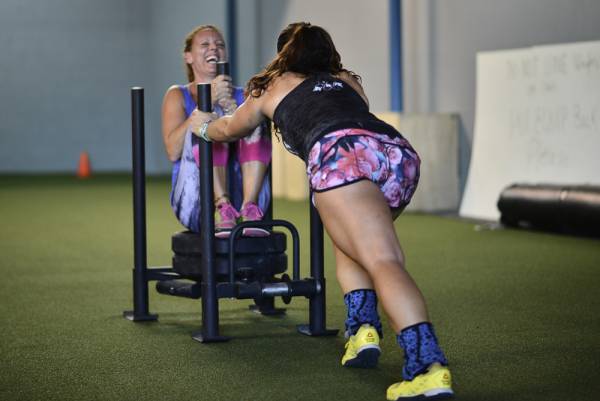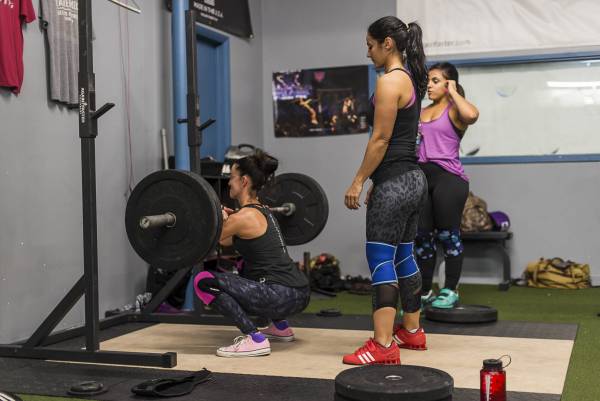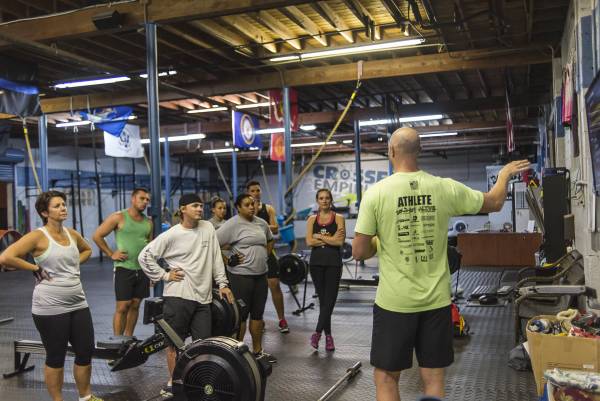When it comes to food, lifting, or love there is no one perfect way. There is only the way that works best for you and fits within the framework of your goals and life.
I do think there is a perfect form of something, though. I believe there is a perfect way to form a strong fitness community. We see a lot of promises of “community” out there (CrossFit affiliates charge around £100.00 per month for it), but what does it actually take to build a strong foundation of people? What does the word “community” even mean in terms of health and fitness?
In my experience, if you aren’t paying attention to your surroundings, a community can be based on some pretty negative stuff, and ain’t nobody got any time for that.
The Idea of Community Versus Reality
During a strange period of my life when I suddenly became afflicted with a full-fledged CrossFit addiction, I joined a “community” of people who paid a car payment of a membership fee every month to cheer each other on while lifting quickly to dubstep music. We bonded over recipes of creations inspired by a mutual eschewing of refined carbohydrates. Personal bests were shared. Facebook group and (gluten-free) outings were regularly scheduled. Unsurprisingly, the conversations at these events generally revolved around gluten avoidance and PBs.
“People should never bond over negativity, whether it is aimed toward each other, avoidance of a particular macronutrient, or a mutual disdain for other forms of exercise.”
At CrossFit GlutenFree, I was selected as one of the “cool kids” and found myself added to an “ultra-secret” Facebook group that contained some pretty scathing background commentary about coaches and other members. As someone who has struggled enormously with weight and body image issues, this threw me into a spiral of shame. I developed some seriously disordered diet and exercise habits. It seemed to me that being a skinny-fat casual lifter was suddenly the worst thing on the planet I could ever be. I went along with some of the bullshit to fit in and to avoid being a target for their jokes. This is something I am still ashamed of to this day.
Meanwhile, outside of the Cool Kids Facebook Group (CKFG), I started to notice other glimpses of negativity: people constantly beating themselves up about their WOD times, criticism from coaches about people’s dietary choices, cliquey behavior at group events. One time, the Cool Kids actually got together to have a PB Fest in front of one of the nighttime classes with the pure intention of making other people feel like shit. Although I tried to be a positive person who got along with everyone (including the CKFG members), I eventually dropped out of the gym to do my own thing.
Note: I am not trying to sit here and journalistically waffle-stomp every CrossFit affiliate on the planet based on personal anecdotes or experience. Some of the most wonderfully inspiring people and coaches I have ever met are within the whiteboard walls of CrossFit GlutenFree.
What I am saying is, community should more than just getting a bunch of people in the same place paying for the same thing. People should never bond over negativity, whether it is aimed toward each other, avoidance of a particular macronutrient, or a mutual disdain for other forms of exercise.

Community Should Enhance Your Life
Here is the main issue I see with a lot of the ideas we have about fitness communities, especially CrossFit: training and diet is not a “lifestyle.” Training and diet is training and diet.
A lifestyle is that of the bartender I met in Steamboat, Colorado who spends half the year slinging slope-side drinks and the other half of the year working a cabana bar in Key West. A lifestyle is built around your own preferences, desires, and goals and should never be something that is preordained by a group. If you are forsaking the things most important to you to adhere to the expectations of a group, you are not in a community. You are in a cult.
“Here is the main issue I see with a lot of the ideas we have about fitness communities, especially CrossFit: training and diet is not a ‘lifestyle.’ Training and diet is training and diet.”
The current community I belong to is a bunch of people who meet a few times a week to lift weights based on some sort of periodization scheme (depending on the individual). We are short, tall, young, old, male, and female. We eat banana muffins, drink BCAAs or coffee for a pre-workout, and foam roll or do dynamic mobility or whatever else to warm up.
It is beautiful because together we share a simple goal – to get stronger. Whatever “strong” might mean to you, and whatever path you choose to get there, that’s all you. I have no idea what my coaches eat. Sometimes I see them lift, but I am not totally sure about their current goals and numbers. I just know they are patient, kind, and supportive. They can answer our questions when we have any, and they leave us alone when we don’t. We have all the resources we need to succeed, and all the room we need to grow.

A True Community
The owner of this gym, my mentor, just lost her sister to cancer. As soon as we all heard the news, a Facebook chat went up: what can we all do to help, when is the memorial, should we do anything at the gym? We don’t have a Facebook group and I barely talk to my gym-mates outside of the weight room. But when we all get together, the bond is stronger than anything else I have ever experienced.
To coaches and gym owners: when is the last time you truly examined the content of your community? I know you have a lot on your plate with memberships, programming, liability, bills, and everything else that goes into ownership. I understand if dealing with interpersonal issues and client psychology and all that jazz is outside of the emotional energy you are able to give after hammering through all the nitty-gritty.
“You can’t just take a bunch of membership contracts, pour gas on them, set them on fire, and pound your chest and yell to the sky ‘I HAVE MADE COMMUNITY.'”
But seriously, who is at your gym? Why are they there? Are there cliquey fractions within your community that might be threatening to undo all of the hard work you put into client acquisition and retention? Are your coaches dealing with members in a healthy way? Are the social events you plan awkward and forced, or do people seem to genuinely enjoy each other’s company? Do you even really need to have social events?

This Isn’t About CrossFit – It’s About People
I get it if all of this rubs anyone the wrong way, especially those who might be members of a CrossFit affiliate. My criticisms are not with CrossFit. Despite the jokes I might make, I think CrossFit is a great thing for a lot of people.
But community is something that needs to be built like a proper fire. You can’t just take a bunch of membership contracts, pour gas on them, set them on fire, and pound your chest and yell to the sky “I HAVE MADE COMMUNITY.” Start with the right ground for your facility, pick a reliable kindling of a strong common purpose, add the right people as wood, feed the fire when needed, let it ebb and flow naturally, and let it burn with positivity and torched goals.
I know that marshmallows aren’t gluten free, but sometimes it can be nice to just sit together and eat some s’mores, you know?
Related Articles:
- Dan John’s Guide to Building an Intentional Community
- When Community Goes Wrong: The Closed-Circle Effect
- Community-Based Fitness: Turning the Tide Toward Health
- What’s New on Breaking Muscle UK Today
Photos courtesy of CrossFit Empirical.






